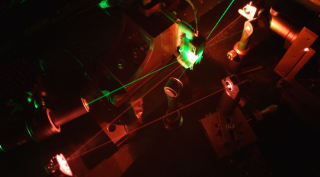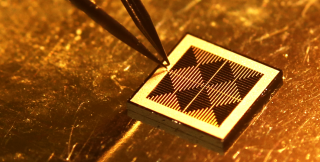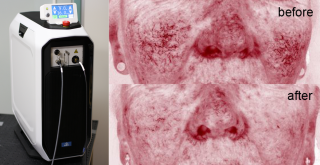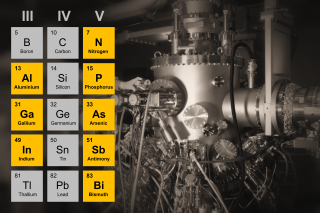Molecular beam epitaxy (MBE)
of new III-V semiconductor materials
Molecular beam epitaxy is the foundation of all our research and development. Our photonic devices are based on III-V semiconductor materials and layer structures grown by molecular beam epitaxy. ORC infrastructure includes five molecular beam epitaxy systems equipped for the growth of all common GaAs, InP, and GaSb-based materials as well as more exotic III-V compounds.
On a more fundamental level or research, we investigate the possibilities of molecular beam epitaxy for the growth of new III-V semiconductor alloys and nanostructures. An important part of our material science and development is the growth of dilute nitride, bismide, and antimonide alloys, which enable bandgap engineering beyond the capabilities of traditional III-V compounds and enable new photonic applications. Our work on III-V semiconductor nanostructures focuses in development of self-assembled and site-controlled epitaxy of III-V semiconductor quantum dots and nanowires, and understanding the fundamentals of their growth processes.
Advanced laser sources
Having in-house capability for epitaxial fabrication of semiconductor gain heterostructures, covering a broad wavelength range from 600 nm to 3 µm, we strive to advance the frontiers of semiconductor laser technology and amplifiers, as well as demonstrating new laser concepts.

The semiconductor laser platforms we are currently developing include laser diodes (LDs), power-scaling using monolithic master oscillator power amplifiers (MOPAs), vertical-cavity surface-emitting lasers (VCSELs), and the new concept of membrane external-cavity surface emitting lasers (MECSELs). Our research is driven by the demands of emerging photonics applications, for example in automotive LIDAR, medicine, or 3D sensing. Specific targets address the need for new wavelengths, increased power, improved efficiency, spectral control, or advanced integration concepts boosting the penetration to photonics technologies. To this end, we are combining our expertise in III-V optoelectronic devices with the silicon-photonics expertise at VTT (the Technical Research Centre of Finland) with the ambition to provide new photonic integration platforms extended from visible to mid-IR wavelengths.
High-efficiency multi-junction solar cells
Solar cells convert sunlight into electricity utilizing the photovoltaic effect. We develop advanced photovoltaic materials and concepts combining expertise on physics, enegineering, and materials science. Our multijunction solar cell (MJSC) technology employing nanophotonic concepts has an ability to reach conversion efficiency beyound 50%. The single crystal solar cell materials and multilayer structures are synthesized by molecular beam epitaxy (MBE) technology. Our current research focuses on MJSC architectures that contain up to six junctions built of various III-V semiconductor materials including GaInP, GaAs and GaInNAsSb (dilute nitride) and exploits nanophotonics concepts for improved use of photons. The converssion efficiencies we have so far demonstrated are surpassing 40% .

The main target applications for the MJSCs are concentrated photovoltaic power plants (CPV) and space photovoltaic systems, such as telecommunication satellites and scientific missions. Thsi area of research is part of major European initiatives targeting new technologies for solar energy generation. More details of the recent development of our MJSCs and photovoltaics of tomorrow can be found in the ERC AdG AMETIST project webpage.
Applications
We are using our leading expertise in light sources and photovoltaics to advance high impact applications in several research areas. Particularly, we have been focusing on medical applications. As a result, we have developed a fully functional laser system emitting yellow light for the treatment of dermatological diseases (e.g. dilated blood vessels on face, port wine stains and hemangiomas). The laser system was tested as part of a clinical trial organized in collaboration with local dermatologists in Tampere.
 The trial was a success not only because of the promising treatment outcome (Karppinen et al. 2019), but also because it is paving the way for other proof-of-concept demonstrations with our leading light source technology. Currently the focus is on developing compact yellow-light-emitting laser diodes for ophthalmology and fluorescence microscopy and broadband light sources for Optical Coherence Tomography (OCT). Other emerging applications include Time-of-Flight LIDAR, advanced gas sensors and advanced photovoltaic systems.
The trial was a success not only because of the promising treatment outcome (Karppinen et al. 2019), but also because it is paving the way for other proof-of-concept demonstrations with our leading light source technology. Currently the focus is on developing compact yellow-light-emitting laser diodes for ophthalmology and fluorescence microscopy and broadband light sources for Optical Coherence Tomography (OCT). Other emerging applications include Time-of-Flight LIDAR, advanced gas sensors and advanced photovoltaic systems.

